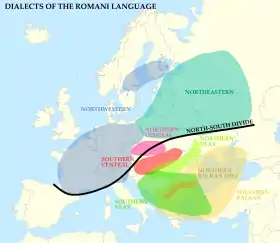
The picture shows the dialects of the Romani, which are under threat of disappearance.
Degree of endangerment is an evaluation assigned by UNESCO to the languages in the Atlas of the World's Languages in Danger.[1] Evaluation is given according to nine criteria, the most important of which is the criterion of language transmission between generations.[2]
Degree of endangerment
| status | explanation | examples[1] |
|---|---|---|
| Safe | The language is used by all generations. The transmission of the language from generation to generation is not disturbed | English, Arabic, Spanish, German, Russian, French and other |
| Vulnerable | The language is used by most children, but it is used with some restrictions. For example, they speak this language only at home. | Adyghe, Anal, Bashkir, Belarusian, Neapolitan, Yiddish and other |
| Definitely endangered | The language is not learned by children as a native | Chuvash, Erzya, Mari, Newar, Romani, Udmurt, Walloon and other |
| Severely endangered | The language is used by older generations and is understandable to parents, but they do not use it when communicating with children and among themselves | Breton, Ingrian, Judaeo-Spanish, Nafusi, Nanai and other |
| Language revitalization | The language is in the process of being restored | Cornish, Manchu, Manx and other |
| Critically endangered languages | Only old people know the language and it is rarely used by them | Dahalik, Duruwa, Orok, Tofa, Ulch and other |
| Extinct language | 1. There are no living native speakers in the world 2. Previously, the language definitely existed, but now there is no reliable information about its state |
1. Dalmatian, Obispeño, Gothic 2. Ancient Cappadocian, Livonian, Yukaghir |
References
This article is issued from Wikipedia. The text is licensed under Creative Commons - Attribution - Sharealike. Additional terms may apply for the media files.